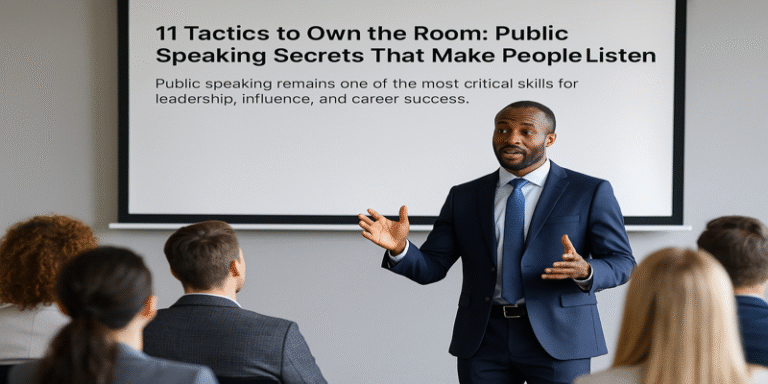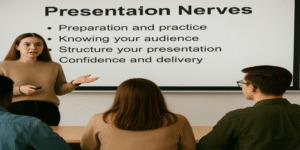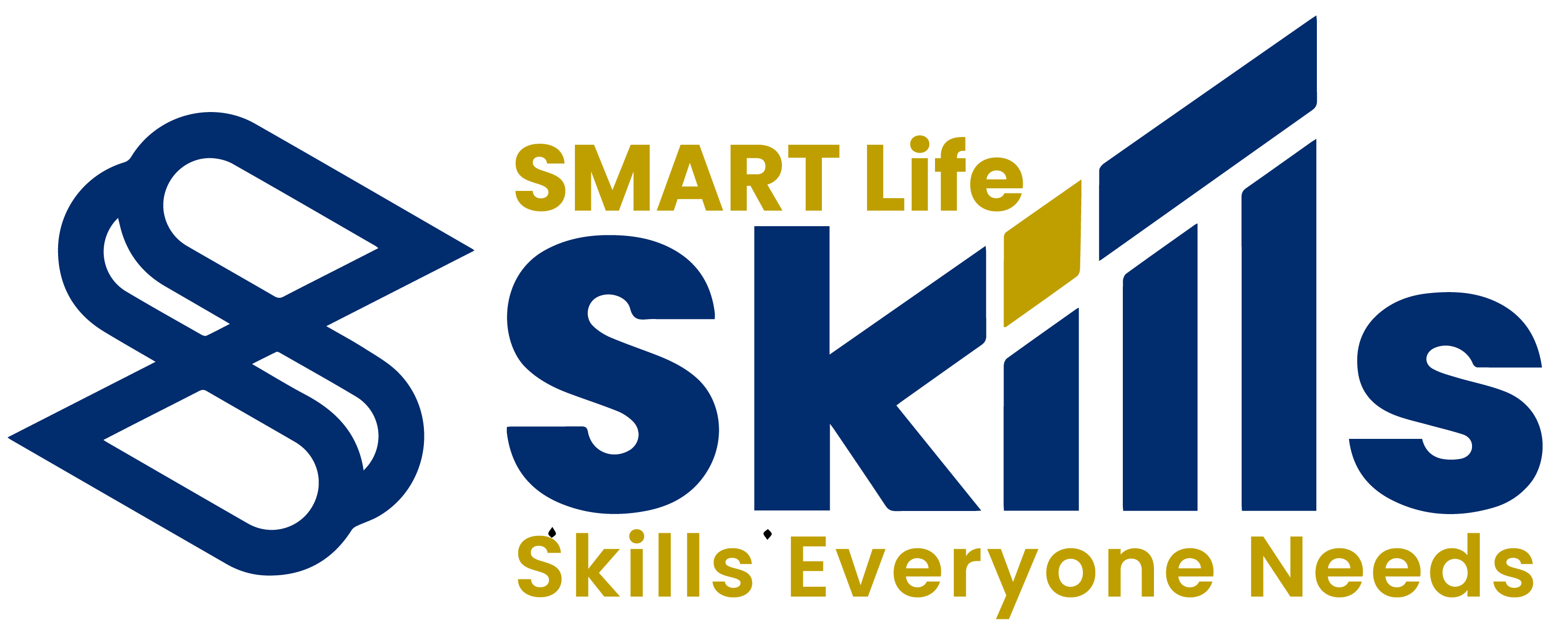Public speaking remains one of the most critical skills for leadership, influence, and career success. The art of commanding attention, engaging the audience, and delivering messages with confidence is not innate—it is cultivated through deliberate techniques grounded in communication science, psychology, and rhetorical theory. This article explores 11 evidence-based tactics for mastering public speaking, aligning each with academic insights and best practices from research and expert literature.
1.0 The Power Pause: Harnessing Silence for Impact
The Power Pause technique leverages strategic silence to enhance message retention. Research indicates that pausing increases listener comprehension and emphasises critical points (Schreiber, Paul & Shibley, 2012). When a speaker pauses for 2–3 seconds after key statements, it signals confidence and allows the audience to process information.
For example, Winston Churchill famously employed deliberate pauses to enhance rhetorical impact. As Hennessey (2019) explains, “Silence is the punctuation of persuasion.” Effective use of silence demonstrates control and self-assurance, attributes associated with powerful speakers.
2.0 Make People Feel Important (SHR Method)
Building rapport with an audience relies on social connection and empathy. The SHR method—See, Hear, Remember—emphasises eye contact, active listening, and personal references to foster inclusion (Scott, Robertson & Tatum, 2024). Communication theorists suggest that human attention increases when people feel personally recognised (Baccarani & Bonfanti, 2015).
Practical application includes greeting participants by name, acknowledging their contributions, or citing a relevant audience example. As Tuhovsky (2015) highlights, effective communicators “make others feel seen before they seek to be heard.”
3.0 The Rule of Three: Structuring for Memory
The Rule of Three reflects a cognitive principle—our brains retain information best when presented in triads. From Aristotle’s logos, ethos, pathos to modern political speeches, this rhetorical pattern enhances memorability (Crick, 2022).
According to Nikitina (2011), structuring points in threes—such as “three steps,” “three benefits,” or “three examples”—creates a natural rhythm that aids recall. Repetition, when used strategically, also reinforces message salience (Zhang, Ardasheva & Austin, 2020).
4.0 The 10-Second Hook: Capturing Attention Immediately
In a world of short attention spans, the first 10 seconds of a presentation determine audience engagement. Neuroscientific studies confirm that attention peaks within the opening moments (Curtis, Jones & Campbell, 2015). Starting with a statistic, story, or bold statement activates curiosity.
For instance, an environmental speaker might begin: “Every minute, the equivalent of one garbage truck of plastic is dumped into our oceans.” Such openings employ what Harrington (2025) calls “the narrative snap”—a moment that hooks both the mind and emotions.
5.0 The Pyramid Principle: Clarity through Structure
The Pyramid Principle, developed by Barbara Minto, recommends starting with the main conclusion, then layering supporting arguments underneath. Baccarani & Bonfanti (2015) note that this logical structure enhances clarity and confidence, particularly in corporate contexts.
For example, a marketing executive might begin, “Our campaign increased engagement by 40%,” before explaining how. This approach ensures cognitive economy, allowing the audience to grasp the key idea early.
6.0 The Contrast Trick: Emphasising Difference
Contrast is one of the most persuasive rhetorical devices. Studies show that contrasting what “most people do” versus what “you do differently” enhances distinctiveness and influence (Mohan, 2019). Humans interpret meaning through differentiation, making contrast an essential persuasive strategy (Crick, 2022).
Example: “Most leaders talk about vision; great leaders make people see it.” This highlights the gap between common practice and excellence, stimulating attention and belief.
7.0 The Two-Minute Story Rule: The Science of Short Narratives
Storytelling remains central to effective communication. However, brevity enhances retention. The Two-Minute Story Rule encourages concise, emotionally resonant stories with a clear turning point and takeaway (Putra, 2024).
McNatt (2019) found that narratives under two minutes sustain engagement without overloading working memory. For example, a short anecdote about overcoming a professional setback conveys resilience more powerfully than lengthy exposition.
8.0 The Mirror Technique: Building Instant Connection
Mirroring—subtly reflecting another person’s tone, gesture, or posture—activates empathy through neural mirroring mechanisms (Warren, 2011). The Mirror Technique enhances perceived similarity and rapport, which are predictors of persuasion and trust (Booher, 2013).
Simple actions such as matching audience energy or echoing a question before answering can subconsciously synchronise speaker and listener. As Leeds (2025) suggests, mirroring “transforms presentation into conversation.”
9.0 Power Position: Confidence through Body Language
Body language constitutes over 55% of communicative impact (Mehrabian, cited in Tuhovsky, 2015). The Power Position—standing tall with feet apart, shoulders back, and open gestures—projects authority and credibility. Physical posture affects psychological state through embodied cognition (Zhang et al., 2020).
Amy Cuddy’s Harvard research on “power posing” supports this; expansive body positions increase testosterone and reduce cortisol, enhancing confidence (Cuddy, Wilmuth & Carney, 2012). Avoiding crossed arms and maintaining eye contact reinforces presence.
10.0 Callback Technique: Creating Circular Closure
The Callback Technique links the end of a speech to its beginning, providing a satisfying sense of closure and coherence. This technique mirrors classical rhetorical “ring composition” and strengthens message recall (Anagel, 2025).
For example, if a talk begins with a childhood story about curiosity, ending with how that curiosity shaped one’s career completes the narrative arc. Nikitina (2011) calls this “the echo of meaning”—a conclusion that resonates.
11.0 Use of Humour: Humanising the Speaker
Humour diffuses tension and enhances relatability. When used appropriately, it increases audience receptiveness and message retention (Harrington, 2025). A well-timed joke or light remark before complex material relaxes listeners, promoting cognitive openness.
However, as Hennessey (2019) warns, humour must be inclusive and contextually relevant. Self-deprecating humour often strengthens rapport by portraying authenticity. For example, British politician Boris Johnson’s playful self-awareness often softened his controversial remarks.
Conclusion: The Psychology of Presence
Mastering these 11 tactics transforms public speaking from mere performance to authentic communication. Across research and rhetorical tradition, three principles recur: clarity, connection, and confidence. These methods—supported by evidence from studies in persuasion, communication psychology, and performance science—demonstrate that powerful speaking is less about innate charisma and more about deliberate strategic behaviour.
As Baccarani and Bonfanti (2015) summarise, “Public speaking is a social act of leadership.” To own the room is to combine structure, emotion, and presence so that every listener feels both enlightened and inspired.
References
Anagel, M.I.G. (2025) Public Speaking Strategies and Oral Production. Universidad Técnica de Ambato.
Baccarani, C. & Bonfanti, A. (2015) ‘Effective public speaking: a conceptual framework in the corporate-communication field’, Corporate Communications: An International Journal, 20(3), pp. 365–377. https://doi.org/10.1108/ccij-04-2014-0025.
Booher, D. (2013) Speak with Confidence! Powerful Presentations That Inform, Inspire, and Persuade. New York: McGraw-Hill.
Crick, N. (2022) Rhetorical Public Speaking: Social Influence in the Digital Age. Routledge.
Curtis, K., Jones, G.J.F. & Campbell, N. (2015) ‘Effects of good speaking techniques on audience engagement’, International Conference on Multimodal Interaction, ACM, pp. 35–42.
Hennessey, A. (2019) Your Guide to Public Speaking: Build Your Confidence, Find Your Voice, and Inspire Your Audience. Adams Media.
Leeds, D. (2025) Power Speak: Engage, Inspire, and Stimulate Your Audience. New York: HarperCollins.
McNatt, D.B. (2019) ‘Enhancing public speaking confidence, skills, and performance’, International Journal of Management Education, 17(2), pp. 285–300.
Nikitina, A. (2011) Successful Public Speaking. Bookboon.
Putra, B. (2024) ‘Unveiling Audience Engagement in Public Speaking: The Strategies’, Journal of English Studies and Business Communication, 2(1), pp. 12–22.
Scott, J.W., Robertson, M. & Tatum, N.T. (2024) ‘Audience Analysis in Public Speaking: A Comprehensive Exploration’, in The Routledge Handbook of Public Speaking. Routledge.
Tuhovsky, I. (2015) Communication Skills Training: A Practical Guide to Improving Social Intelligence, Presentation, Persuasion, and Public Speaking. CreateSpace.
Zhang, X., Ardasheva, Y. & Austin, B.W. (2020) ‘Self-efficacy and English public speaking performance: A mixed-method approach’, English for Specific Purposes, 59, pp. 1–13.









